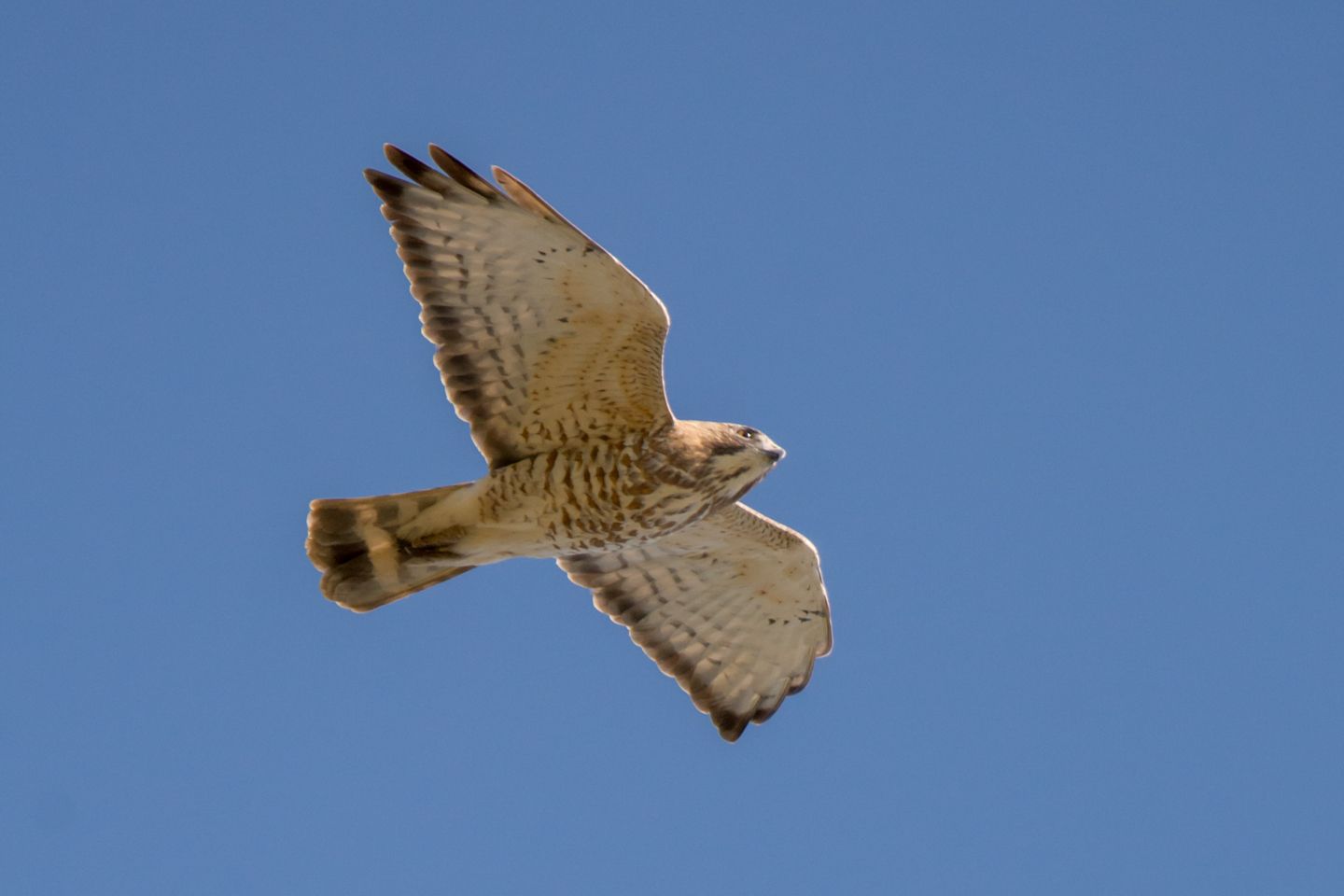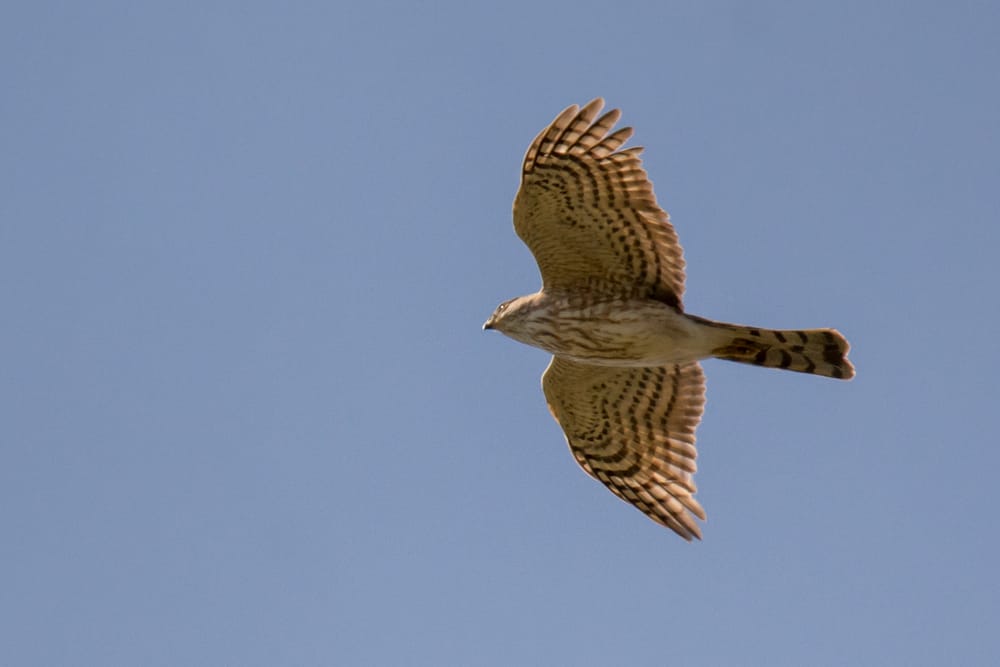Broad-winged Hawks Return!
by: Sherri Leigh Smith
The last ten days of April and the first week of May can produce large passages of northbound hawks through our region. This is the migration time for large numbers of Broad-winged Hawks. Thousands to tens of thousands of this species must pass through our area. I say ‘must’ because once they soar over Onondaga Audubon's Derby Hill Bird Observatory, they seem to vanish. Since the development of Doppler radars, we have begun to understand these birds' migration patterns through our region. There is still much to be learned by visual observations and applications of new technologies, about where and how these birds move north and south.

This species has been a source of great interest in northeastern North America literally for centuries. An observation in late April 1763, near present-day Brattleboro, Vermont, reports a great "battle" by large armies of hawks. Although the eighteenth-century interpretation of the event is rather fanciful, clearly, a large hawk migration, probably comprised primarily of Broad-wings, was occurring. This species remains fairly common in our century, but their numbers prior to deforestation in the Americas may have been truly spectacular. Unfortunately, we have little information on all aspects of their ecology prior to the twentieth century
The Broad-winged Hawk is a medium-sized forest hawk similar in shape to our familiar Red-tailed Hawk. Though close relatives, the Broad-winged is a bird of forested regions, while the Red-tail prefers a more open landscape. The former species is a spectacular long-distance migrant, while the latter is generally a short to mid-distance traveler. Red-tails usually migrate as singles and pairs, but may associate in small groups. Broad-wings can form enormous flocks at migration bottlenecks that may number in the hundreds to tens of thousands.

Broad-winged Hawk migration ecology has been studied from Eastern Canada to Northern South America. These birds are excellent at soaring, thus expending little energy during their monumental journeys. Data indicate that in fall migration, no food consumption occurs between thirty degrees north latitude in Texas, until they exit Panama and enter Northern South America. They survive on their fat reserves. This is made easier by the strong thermals, rising bubbles of hot air, which are particularly well developed in the tropics. Riding these natural elevators to the heavens, they travel great distances effortlessly. Evolution has adapted these birds for journeys through areas where so many hawks would have difficulty finding meals.
Broad-winged Hawks spend about four and a half months annually on their North American breeding grounds. They spend about four months on migration and the remaining time on their South American wintering grounds. While much of the population nests in Canada from the Great Lakes eastward, many birds nest throughout the eastern United States. In our region, pairs breed wherever sizeable chunks of forest exist. The Algonquin to Adirondacks (A2A) corridor that encompasses our region is probably good habitat. Unfortunately, as with most forest raptors, this species is quite secretive when nesting, so data are limited.
As migrant Broad-wings undoubtedly stream overhead through our region, they are rarely seen by ground based human observers. Most local breeders have dropped onto territories by late April and nests are then prepared for egg-laying. For a common species, the breeding ecology of this secretive woodland Buteo is poorly known. Available data indicate the nest is ready by the third week of May, and 2-4 eggs are laid. After about a month of incubation, the young hatch. After about another month, they take their first flights. Another month and they are hunting on their own and fully-fledged.

At our latitude, young recently-fledged Broad-winged Hawks are on the wing by mid-August and ready to begin their monumental journey to the Tropics. The fall migration of this species is overall the best-known aspect of their life cycle. Beginning in the third week of August, great streams ride thermals and winds from eastern North America to the northern half of South America. The multiple flight lines of southbound "broadies" have hawk watchers atop many New England mountains. During the peak flights of mid-September, there are many human eyes peering into the skies throughout northeastern North America.
These efforts have documented the waves of hawks that usually reach south Texas in late September and early October, before moving into Mexico. Hawk watchers in the tropical regions have been relatively rare until the 1990s. Their efforts in the last thirty years have shown that vast concentrations of tropical migrant raptors occur at sites in Meso-America. Near Veracruz, in southern Mexico, counts are in the millions. Other locations have recently been discovered in Central America. By November, most birds have reached wintering grounds throughout southern Central America and Northern South America.
By mid-March, the journey north for adult birds begins again. Once they leave south Texas in late March, they are generally poorly detected until reaching the Great Lakes region. The lakes form a barrier to a species that is a largely averse to flying across large bodies of water. As soaring birds that use thermal lift, which is weaker over water than over land, they are out of their comfort zone over big water and prefer to work around it. This is particularly true in spring, when surface temperatures of larger bodies of water are substantially colder than in late summer.
Thus, locally, the spring migration of this species piles up near the south shore of Lake Ontario. The Derby Hill Bird Observatory of Onondaga Audubon is located near the southeastern corner of the lake, thus at a concentration bottleneck for spring migration. Weather cooperating, spectacular flights can occur at or near this site. Daily movements in the thousands have been recorded during the last ten days of April. Once the adults pass north to breed, Broad-wing migration slows and by late May, a final burst of young birds appears. Since these birds will not breed but are undertaking a migration of thousands of miles, one wonders why.


Broad-wing Hawk [©Photos by Julie Covey, Nature in NY (https:www.facebook.com/NatureinNNY/)]
Many of these young are in heavy molt and "appear unsafe at any speed," since it often looks as though they shouldn't remain airborne. The adaptive value of these young (that play no part in maintaining the species) migrating at a time when molting, an energy stressor on any bird, seems a conundrum. Perhaps escaping the intense ecological pressures of tropical diseases, competition for food, and other factors, for more favorable northern climes, plays a part in what seems like a risky journey of limited value.
Even though the migration ecology of the Broad-wing is well known in parts of eastern North America, it's still poorly understood in our region. Once those streams move north of Derby Hill in spring, they are rarely detected. The picture is even less clear in autumn. Observers who look up in late summer and early fall in our region, as well as late April, could contribute to local ornithology. If you see Broad-winged Hawk flocks' movements along or over the St. Lawrence, report them to E bird and/ or drop me an email at goshawk@gisco.net. There is much to be learned about hawk migration locally, and even anecdotal observations have value.
Good birding.
By Sherri Leigh Smith, goshawk@gisco.net
Photographs by Julie Covey, Nature in NY (https:www.facebook.com/NatureinNNY/)]
Sherri Leigh Smith is the Senior Ornithologist in northern NY. She is passionate about birds and their conservation. Sherri Leigh has written numerous articles for TI Life, and you can see several of them here.
Editor’s Note: This editor is both pleased and appreciative to Sherri Leigh Smith for taking the time to help us understand more about nature in the islands. She and nature photographer Julie Covey, have provided a wonderful sample for the fall of 2020, the winter of 2021 and now spring 2021. Already I am getting better at looking at the sky and those flying by as well as understanding the how and why!






Please click here if you are unable to post your comment.